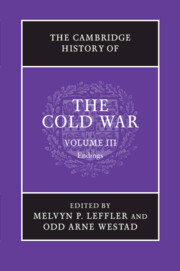Book contents
- Frontmatter
- 1 The Cold War and the intellectual history of the late twentieth century
- 2 The world economy and the Cold War, 1970–1990
- 3 The rise and fall of Eurocommunism
- 4 The Cold War and Jimmy Carter
- 5 Soviet foreign policy from détente to Gorbachev, 1975–1985
- 6 Islamism, the Iranian revolution, and the Soviet invasion of Afghanistan
- 7 The collapse of superpower détente, 1975–1980
- 8 Japan and the Cold War, 1960–1991
- 9 China and the Cold War after Mao
- 10 The Cold War in Central America, 1975–1991
- 11 The Cold War and southern Africa, 1976–1990
- 12 The Gorbachev revolution and the end of the Cold War
- 13 US foreign policy under Reagan and Bush
- 14 Western Europe and the end of the Cold War, 1979–1989
- 15 The East European revolutions of 1989
- 16 The unification of Germany, 1985–1991
- 17 The collapse of the Soviet Union, 1990–1991
- 18 Science, technology, and the Cold War
- 19 Transnational organizations and the Cold War
- 20 The biosphere and the Cold War
- 21 The Cold War and human rights
- 22 The Cold War in the longue durée: global migration, public health, and population control
- 23 Consumer capitalism and the end of the Cold War
- 24 An ‘incredibly swift transition’: reflections on the end of the Cold War
- 25 The restructuring of the international system after the Cold War
- Bibliographical essay
- Index
- References
22 - The Cold War in the longue durée: global migration, public health, and population control
Published online by Cambridge University Press: 28 September 2010
- Frontmatter
- 1 The Cold War and the intellectual history of the late twentieth century
- 2 The world economy and the Cold War, 1970–1990
- 3 The rise and fall of Eurocommunism
- 4 The Cold War and Jimmy Carter
- 5 Soviet foreign policy from détente to Gorbachev, 1975–1985
- 6 Islamism, the Iranian revolution, and the Soviet invasion of Afghanistan
- 7 The collapse of superpower détente, 1975–1980
- 8 Japan and the Cold War, 1960–1991
- 9 China and the Cold War after Mao
- 10 The Cold War in Central America, 1975–1991
- 11 The Cold War and southern Africa, 1976–1990
- 12 The Gorbachev revolution and the end of the Cold War
- 13 US foreign policy under Reagan and Bush
- 14 Western Europe and the end of the Cold War, 1979–1989
- 15 The East European revolutions of 1989
- 16 The unification of Germany, 1985–1991
- 17 The collapse of the Soviet Union, 1990–1991
- 18 Science, technology, and the Cold War
- 19 Transnational organizations and the Cold War
- 20 The biosphere and the Cold War
- 21 The Cold War and human rights
- 22 The Cold War in the longue durée: global migration, public health, and population control
- 23 Consumer capitalism and the end of the Cold War
- 24 An ‘incredibly swift transition’: reflections on the end of the Cold War
- 25 The restructuring of the international system after the Cold War
- Bibliographical essay
- Index
- References
Summary
A three-volume history is an impressive monument to Cold War studies. But could it one day be seen as a tombstone? The grave danger inherent in superpower relations might appear to provide enduring reasons to continue studying them indefinitely. A different outcome, after all, could have changed everything. Yet this argument would base the importance of the Cold War on shifting ground: something that might have happened. Only a handful of crises had truly catastrophic potential, and treating them to ever more fine-grained analyses yields diminishing returns. As the Cold War continues to recede into history, scholars will therefore have to work harder to explain its importance to future generations.
If one instead turns to the history of populations and public health – the kind of “structural” history favored by the followers of Fernand Braudel – the period coinciding with the Cold War can be shown to have witnessed changes that were comparable to the impact of global nuclear war, only these changes unfolded over decades and had nearly the opposite demographic effects. The number of people living on earth more than doubled between 1945 and 1989. By the time Germans were living under one government again, world population was growing by the number of people in the reunited nation – more than 80 million – each and every year. The overwhelming majority of them were being born in Asia and Africa. For the largely Russian leadership of the USSR, the higher fertility of Central Asians appeared to pose an existential threat.
- Type
- Chapter
- Information
- The Cambridge History of the Cold War , pp. 466 - 488Publisher: Cambridge University PressPrint publication year: 2010
References
- 5
- Cited by



